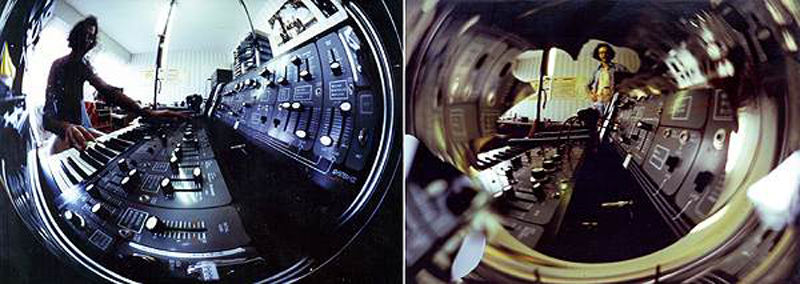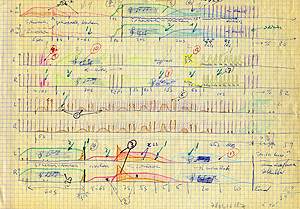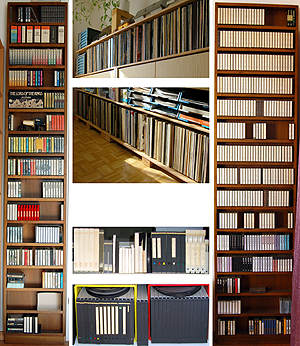
< Personal
> Intro
• Audio
> Computer
> Internet
> Network
— Private: Audio —
Audio — Tape Recording and Sound Sculptures
I got enthused by radio at quite an early age — my technical side — and that led to the trade I learned eventually. We had a piece of equipment at home that could record sound on a steel wire and a microphone for it, too. Playing with this gave me enormous fun. When I earned some money later on, I purchased open reel tape recorders and portable cassette recorders, microphones, built a 24 channel mixer …

… and filters for the analogue voltage controlled electronic music synthesizer, bought an echo-reverb chamber (with tape loop), flanger (comb filter with BBD) and built up a small home studio.

I collected sounds and noises, produced radio plays using the voices of other enthusiasts, tried a bit to make music and used the synthesizer mainly to synthesise sounds which I assembled to compositions which I called Sound Sculptures. I started to seriously experiment with dummy head recording and got quite interested in how we perceive sound. Like the eye can be fooled when using appropriate pictures, the ear can be fooled, too.

I was moderately successful at competitions and won a hi-end cassette recorder, a CD player, microphones, tape reels and the like. I was an active member — even on the board — of the Cassettentonbandclub (society of the cassette tape recordists) and the Tonjägerverband (federation of the tape recordists). I was an active member of the German Arbeitskreis Musikelektronik e.V. (working group music electronics) for a couple of years and led the Swiss chapter.
When audio got digital, there was not enough money left to invest in new equipment — I got married, a daughter was born and then another one — and there was something new and very fascinating appearing on the horizon. What is left from the tape recording hobby is corresponding with friends in the round robin manner. This can be highly recommended to improve a foreign language!
There are a few examples made available as MP3 podcasts. The picture shows a sketch of the «composition» for Encounter. For each sound, schematics were drawn that showed how the different function generators and filters of the synthesizer had to be hooked up and to which value each parameter had to be set. Procedures to start and use the effects equipment, tape recorders, mixer, and so on, at any moment were written.
-
Szene (scenery in southern Greenland), ca 1978, ca. 4 Min, 2.9 MB.
Zug (train) Depart, ca 1978, ca. 2 Min, 2.3 MB.
Zug (train) Transit, ca 1978, ca. 1 Min, 1.4 MB.
Erdgeister (ghosts), September 1979, ca. 17 Min, 12.5 MB.
Encounter, March 1981, ca. 12 Min, 9.3 MB.
Environment, June 1981, ca. 11 Min, 10.3 MB.

Note: The sound sculptures were optimised for headphone listening.
|
The synthesizer was given away a few years ago, after all, you can use the computer to create music if you take the time necessary for it. Sound and Music Archive Instead of bringing back loads of photographs from my voyages through Europe, I brought back cassettes full of sounds collected. These I used to assemble holiday radio plays. I also collected many radio plays using a switch clock to start up the equipment when I was away at work. Therefore, a considerable amount of cassettes and reels collected. Because I was very much concentrated on the ear at that period of time, I purchased a lot of records. There are few types of music I dislike, arias of operas are among them and the minimalist popular music of today. I have never found access to modern jazz. Considering the classic type of music, the first two names are Beethoven and Bach, for the entertainment type Chuck Berry and the Rolling Stones — and as a contrast Vienna Teng. When working at home, rock music is very good to stimulate while the classical serves to relax and creates the recompense. |

|
© 2004 - 2018 by Horo Wernli.